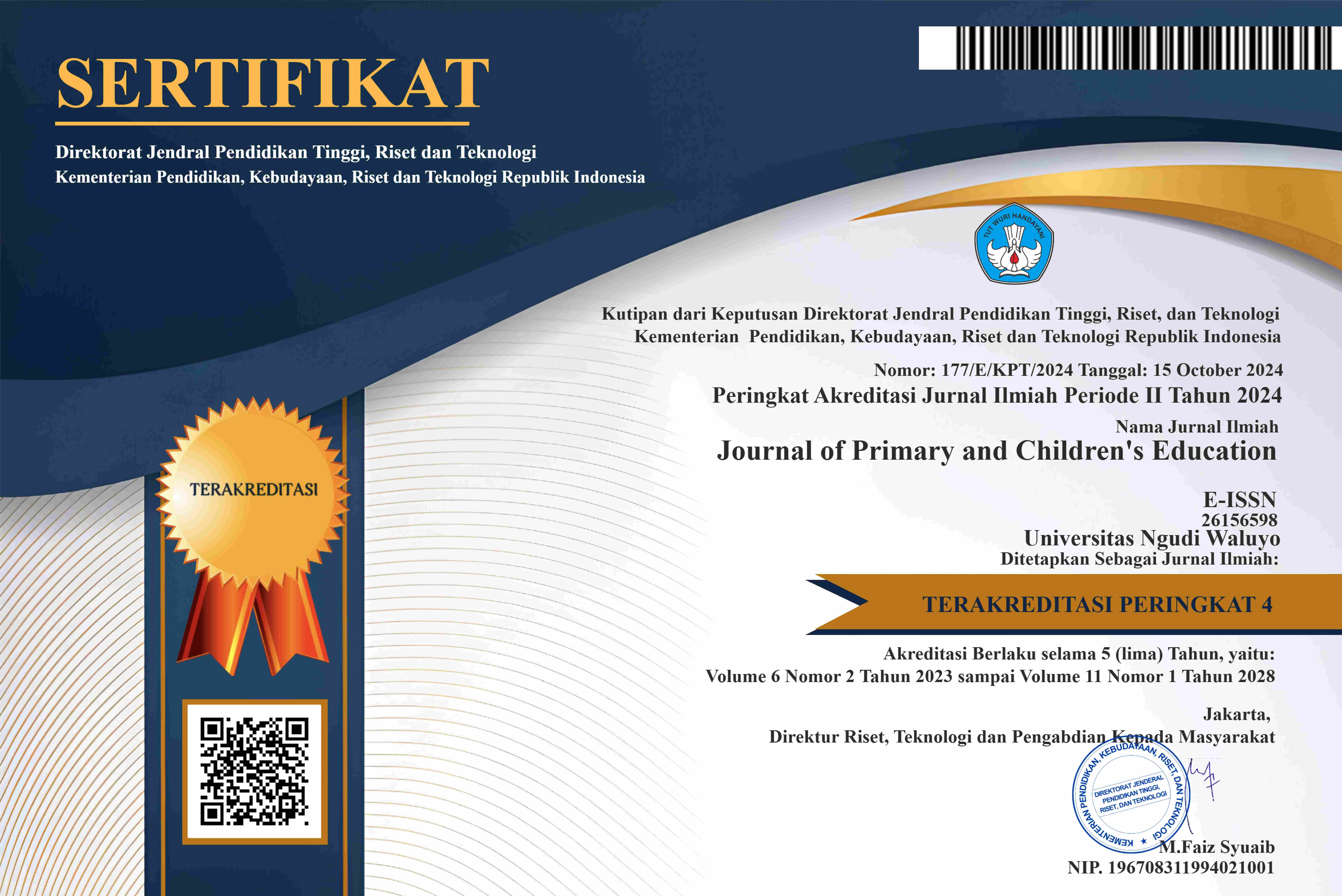Penerapan Model Polya Terhadp Hasil Belajar Soal Cerita Matematika Materi Perkalian dan Pembagian Siswa Kelas IV SDN 1 Tedunan Kabupaten Jepara
DOI:
https://doi.org/10.35473/jnctt.v3i1.301Abstract
In learning Mathematics, conceptual understanding is a primary competency that the students must acquire, because through understanding the concept the students would understand what is being learned and are able to apply them thus they can pursue toward the next materials. However, in the reality of a learning process, the students have not yet understood the correctly. Therefore, researchers applied the Polya model. Thus, this study applies a learning model that can be applied and improves the learning outcomes of fourth grade students at SDN 1 Tedunan, Jepara Regency. This research method is quantitative research. In this research, the research is Des Experiment Desaign with the design of one group prettest-posttest. This study uses a pretest-posttest technique to improve problem solving skills in students. prestest is preliminary data obtained before students are treated using the polya model. Posttest is the final data obtained after students are treated using the polya model. This research was conducted on the fourth grade students at SDN 1 Tedunan Jepara Regency in the academic year 2019/2020 instruments used in this study were test sheets, lesson plans, validity tests, reliability tests. Level of pain and distinguishing power. Can decide the solution to the application of the model can be applied and improve problem solving solutions in fourth grade students at SDN 1 Teduana, Jepara RegencyReferences
Arifin, Z.2013. Penelitian Pendidikan. Bandung: Remaja Rosdakarya
Arikunto. 2013.Dasar- Dasar Evaluasi Pembelajaran. Jakarta: Bumi Aksara
Baharudin, H. Wahyuni, Nur Esa. 2007. Teori Belajar & Pembelajaran. Jogjakarta: AR-RUZZ MEDIA.
Susanto, Ahmad. 2016. Teori Belajar dan Pembelajaran di Sekolah Dasar. Jakarta: KENCANA.
Erza, Arfika Fela. 2016. “Pengaruh Komunikatif Penerapan model NHT Terhadap Hasil Belajar Matematika Berbantu Media Konkriet Siswa Kelas IV SDN Maribaya 02 Kab.Tegalâ€. Skripsi PGSD Universitas PGRI Semarang.
Setiowati, Liana. 2018. “Penerapan Metode Problem Solving Model Polya Terhadap Kemampuan Memecahkan Masalah Pada Materi Oprasi Hitung Campuran Kelas III SDN Mangunharjo Semarangâ€. Skripsi PGSD Universitas PGRI Semarang.
Adjie, Nahrowi. Maulana. 2006. Pemecahan Masalah Matematika. Bandung: UPI PRESS
Winarni, Styo Endang. Harmini, Sri. 2014. Matematika Untuk PGSD. Bandung: PT REMAJA ROSDAKARYA.
Trianto. 2007. Model-Model Pembelajaran Inovatif Berorientasi Konstruktivistik. Jakarta: PRESTASI PUSTAKA.
Makmun Al Ayu, Desy. 2017. “Pengaruh Media Kapedape (Kantong Perkalian dan Pembagian) Terhadap Hasil Belajar Siswa Kelas II Pada Materi Perkalian dan Pembagian di SD Negeri 01 Ngrandah Kab. Grobokanâ€. Skripsi PGSD Universitas PGRI Semarang.
Hamzah, Ali. 2014. Perencanaan dan Strategi Matematika. Jakarta: PT Raja Grafindo Persada.
Sugyono. Metode Penelitian Pendidikan ( Pendekatan Kuantitatif, Kualitatif, dan R&D). Bandung: ALFABETA.
Arikunto, Suharsini. 2010. Prosedur penelitian : Suatu pendekatan Praktik. Jakarta : Rineka Cipta.
Soegeng, A.Y. 2015. Dasar-dasar Penelitian. Yogyakarta : Magnum Pustaka Umum.
Heruman, 2008. Model Pembelajaran Matematika Di sekolah Dasar. Bandung : PT REMAJA POSDAKARYA.
Rusman,2012. Model-Model Pembelajaran Mengembangkan Profesi Guru. Jakarta : PT RAJAGRAFINDO PERSADA.
Hartiny, Rosma. 2010. Model-Model Penelitian Tindakan Kelas. Yogyakarta : Sukses Offset.
Affandi, Khoer. 2010. Sejarah Matematika. Sleman Yogyakarta : Teras.
Putu Yulis heny. 2014. “Pengaruh Model Pembelajaran Polya Terhadap Hasil Belajar Matematika Siswa Kelas IV SD Gugus 1 Kecamatan Tampaksiringâ€. Jurnal Mimbar PGSD universitas Pendidkan Ganesa. Laman: http://garuda.ristekdikti.go.id/journal/article/145704
Sari Kusuma dewi. “Penerapan model Polya Untuk Meningkatkan Hasil Belajar Dalam Memecahkan Soal Ceita Matematika Siswa Kelas Vâ€. Jurnal Mimbar PGSD universitas Pendidkan Ganesa. Laman: http://garuda.ristekdikti.go.id/journal/article/145704
Published
How to Cite
Issue
Section
License
Copyright notice:
- Authors retain copyright and grant the journal right of first publication with the work simultaneously licensed under Creative Commons Attribution License that allows others to share the work with an acknowledgement of the work's authorship and initial publication in this journal.
- Authors are able to enter into separate, additional contractual arrangements for the non-exclusive distribution of the journal's published version of the work (e.g., post it to an institutional repository or publish it in a book), with an acknowledgement of its initial publication in this journal.
- Authors are permitted and encouraged to post their work online (e.g., in institutional repositories or on their website) prior to and during the submission process, as it can lead to productive exchanges, as well as earlier and greater citation of published work (The Effect of Open Access)







